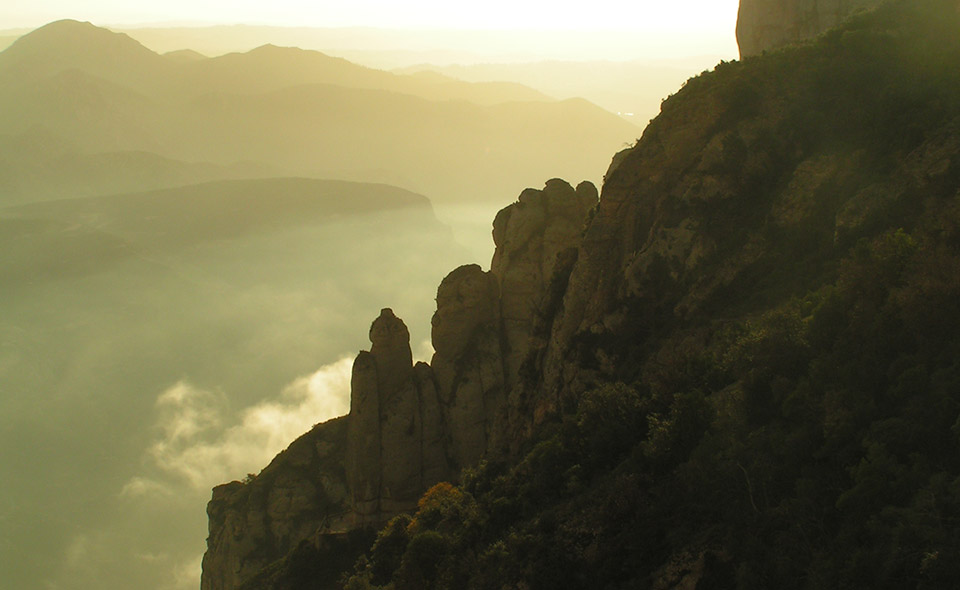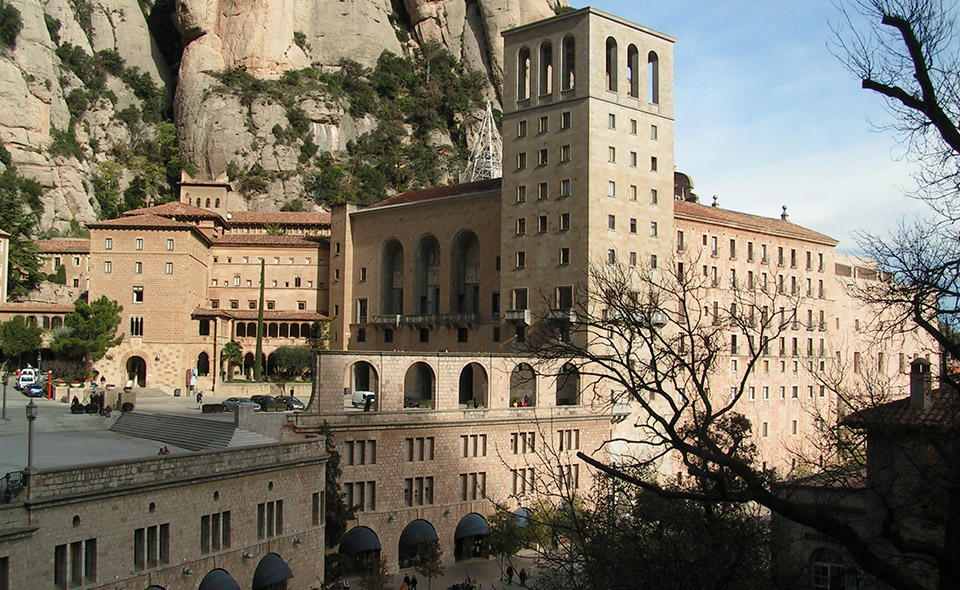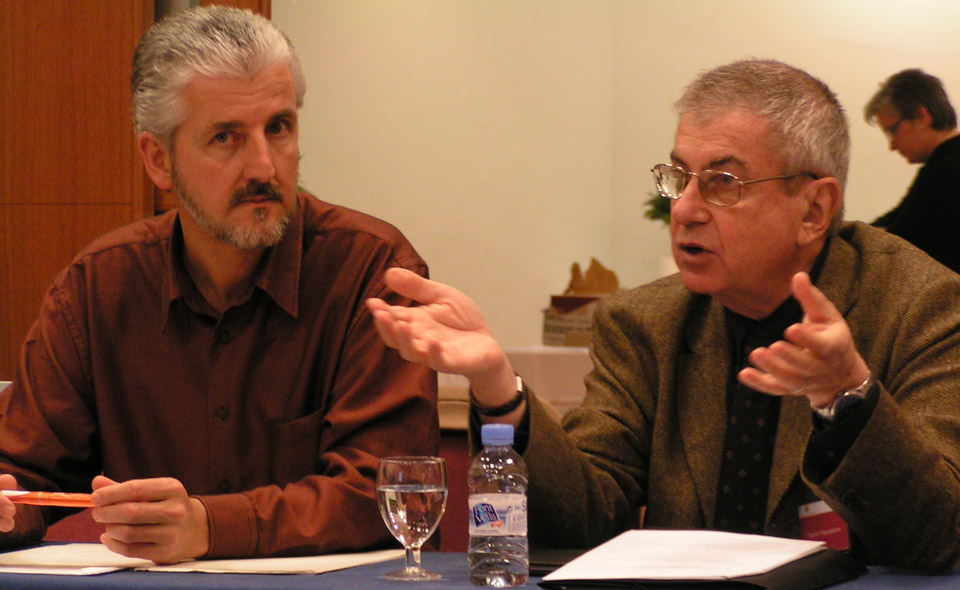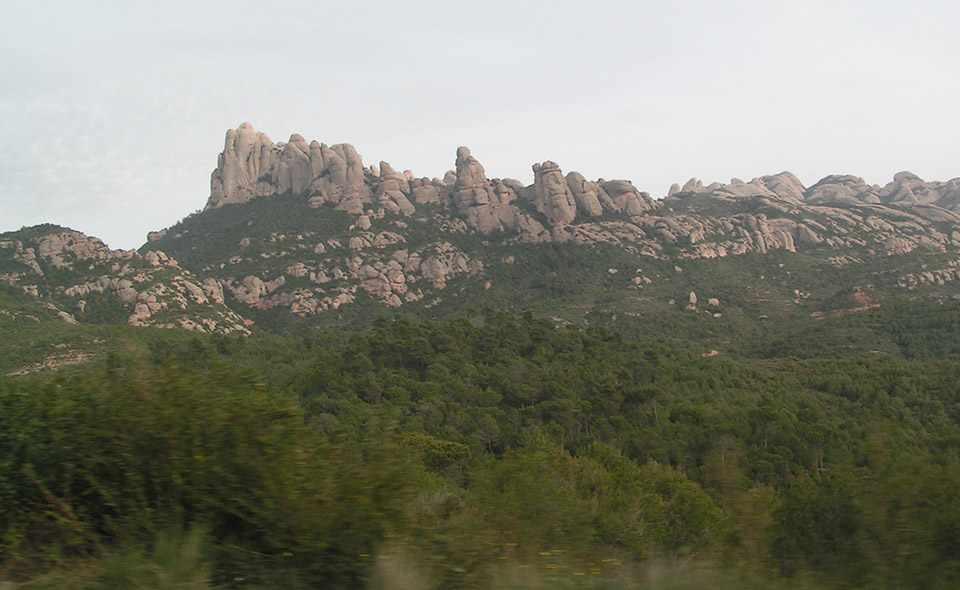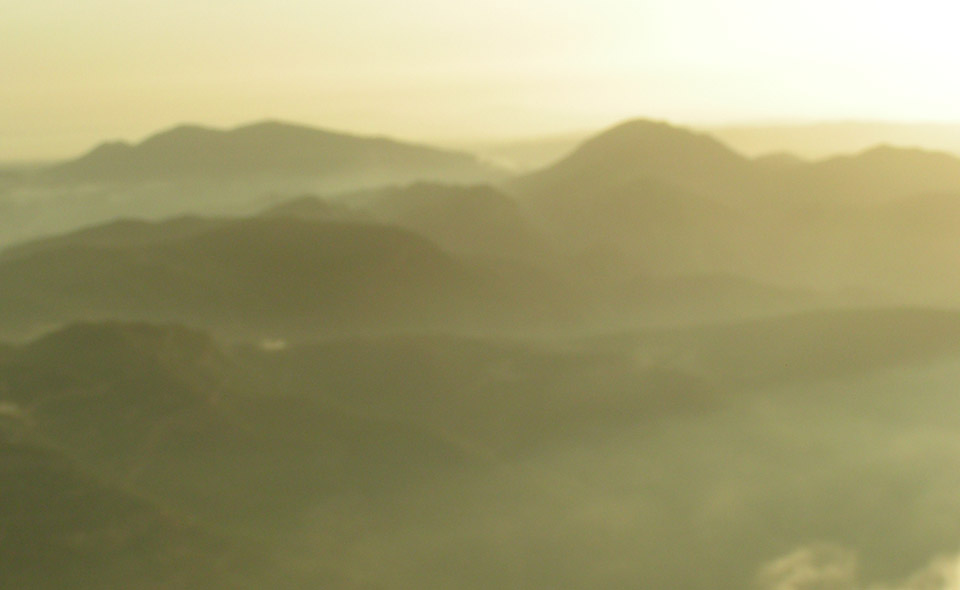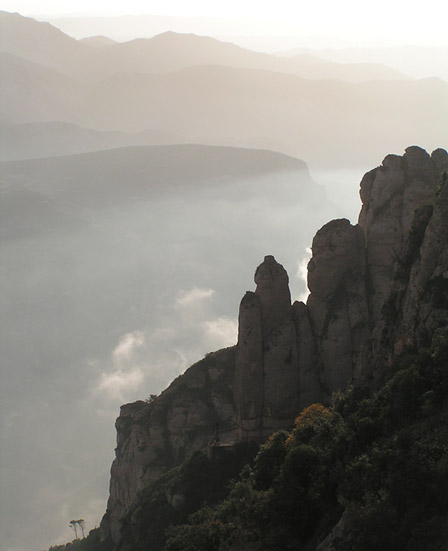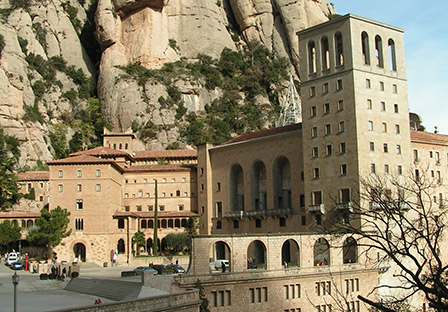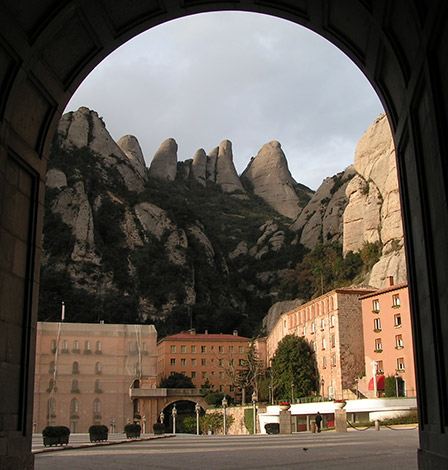जागा
बरेच लोक आश्चर्यकारक रॉक पिनकल्स आणि मॉन्ट्सराटवरील मठांना कॅटालोनियाचे आध्यात्मिक हृदय मानतात. बार्सिलोना मेट्रोपॉलिटन क्षेत्रात ते फक्त आहेत 50 संरक्षित क्षेत्रात असलेल्या शहरापासून किमी अंतरावर. स्थानिक बेनेडिक्टाईन मठातील समुदायाने मॉन्टेराटची काळजी घेतली आहे कारण ते तिथे स्थायिक झाले आहेत 1025. मॉन्ट्सरॅटने नेहमीच यात्रेकरूंना आकर्षित केले आहे परंतु ‘80 च्या दशकापासून, मॉन्ट्सरॅटने अभ्यागतांच्या वाढत्या संख्येचे स्वागत केले आहे, दहा लाखो लोकांचा अंदाज आहे. संरक्षित क्षेत्र आणि स्थानिक नगरपालिकांच्या मंडळासह, अद्वितीय नैसर्गिक जपण्यासाठी भिक्षूंनी काम केले आहे, मॉन्ट्सरॅटची सांस्कृतिक आणि धार्मिक मूल्ये आसपासच्या वाढत्या महानगरांद्वारे उद्भवलेल्या धमक्यांविरूद्ध ती ढाल करा.
धमक्या
भूस्खलन, खडक पडतो, वादळ आणि जंगलातील आग हे स्थानिक वनस्पती आणि जीवजंतूंना युगानुयुगे धोका देत आहेत आणि वाढत्या बदलत्या हवामानामुळे ते आणखी वाईट होऊ शकतात. 1800 च्या उत्तरार्धापासून, साइटवर पर्यटकांचा दबाव सातत्याने वाढला आहे, आणि अभ्यागतांची संख्या आता एकूण पोहोचते 3 दर वर्षी दशलक्ष. यापैकी, काही 2,3 दशलक्ष लोक सांता मारियाच्या मठाभोवती केंद्रित आहेत आणि मठातील शांतता आणि शांततेवर गंभीरपणे परिणाम करतात. डोंगराच्या खालच्या भागात, शहरीकरण झपाट्याने पसरत आहे आणि शेजारच्या पर्वतरांगांशी पर्यावरणीय आणि लँडस्केप कनेक्टिव्हिटी प्रभावित करत आहे.
दृष्टी
या आदरणीय पवित्र नैसर्गिक साइटमध्ये शांतता आणि चिंतन मध्यवर्ती राहिले पाहिजे, आणि व्यवस्थापन योजना त्या मार्गाने निर्देशित केल्या आहेत. पर्वताच्या खालच्या भागात कृषी उद्यानाच्या रूपात संरक्षित जमिनीच्या पृष्ठभागाच्या वाढीसाठी अनेक नगर परिषदा लॉबिंग करत आहेत.. या घडामोडी शहरी अतिक्रमणापासून साइटचे संरक्षण करण्यास मदत करतील आणि विशेषतः खालच्या ऑलिव्ह ग्रोव्हमध्ये शांतता आणि शांततेत योगदान देतील..
कृती
मध्ये 2006 डेलोस इनिशिएटिव्हची पहिली कार्यशाळा मॉन्सेरात येथे आययूसीएनच्या सहकार्याने आयोजित करण्यात आली होती, पार्क बोर्ड, कॅटालोनियाचे पर्यावरण मंत्रालय आणि मठातील अधिकारी. मुख्य भागधारकांसह कॅटलान फेडरेशन ऑफ हायकिंग अँड क्लाइंबिंग क्लब यांच्याशी भिन्न दृष्टीकोनांची देवाणघेवाण झाली, मॉन्टसेराटचे शिखर आणि भिंती देखील एक अत्यंत मौल्यवान गिर्यारोहण क्षेत्र असल्याने. मॉन्टसेराट येथे विविध रूची आणि मूल्ये यांच्यात समन्वय साधणाऱ्या योजनांच्या विकासासाठी कार्यशाळेने प्रारंभ बिंदू म्हणून काम केले..
धोरण आणि कायदा
मॉन्सेरातला राष्ट्रीय उद्यान घोषित करण्याचे प्रयत्न २०१५ मध्ये सुरू झाले 1902, कॅटालोनियाच्या संसदेने वास्तविक कायदा २०११ मध्ये झाला 1989, जेव्हा ते नैसर्गिक उद्यान घोषित करण्यात आले (IUCN श्रेणी व्ही) निसर्ग राखीव परिसर (IUCN श्रेणी III). आजूबाजूला 75 % संरक्षित क्षेत्र एकतर मठ समुदायाचे आहे किंवा कॅटलान सरकारचे आहे. बाकीचे उद्यान, प्रामुख्याने कमी उंचीवर, खाजगी मालमत्ता आहे. संपूर्ण उद्यान युरोपियन निसर्गात समाविष्ट आहे 2000 नेटवर्क.
परिस्थिती विज्ञान आणि जैवविविधता
मॉन्टसेराटचा पृष्ठभाग सुमारे आहे 45 किमी² आणि त्यात मुख्यतः तृतीयक खडक आणि वाळूचे खडक असतात. जरी बहुतेक खडक उघडे आहेत, काही भूमध्यसागरीय वनस्पतींनी झाकलेले आहेत, पुरेशी माती असलेल्या ठिकाणी सदाहरित होल्म ओक जंगले स्थापन केली जातात. मोन्सेरात यांचे घर आहे 1200 संवहनी वनस्पती taxa ओळखले, 40 जे दुर्मिळ किंवा धोक्यात आहेत, जसे इरोडियम फेटिडम, रामोंडा मायकोनी आणि कॉलस सॅक्सिफ्रेज. साइटवर असुरक्षित आणि दुर्मिळ स्पॅनिश Ibex द्वारे वस्ती आहे (स्पॅनिश शेळी) आणि बोनेलीचा गरुड (पट्टी बांधलेला गरुड).
संरक्षक
मॉन्ट्सरॅटचा नर बेनेडिक्टाईन मठ समुदाय जवळजवळ सहस्राब्दीसाठी डोंगरावर राहत आहे. संपूर्ण शतकानुशतके हर्मीट्सने सर्वात दुर्गम आणि बर्याचदा खडकांच्या निर्मितीच्या वरच्या प्रदेशात स्थित वेगळ्या आश्रयस्थानांचा ताबा घेतला आहे.. डोंगराच्या दुसऱ्या भागात एक महिला मठ समुदायाची स्थापना झाली 50 वर्षांपूर्वी. दोन्ही नर आणि मादी मठवासी समुदाय पवित्र स्थान आणि समुदायाबद्दल प्रशंसा करतात जिथे ते शांतता आणि चिंतन यासारख्या मूल्यांचा आदर करतात. ते पवित्र पर्वताचे धार्मिक आणि प्रतिकात्मक मूल्य असल्याचे वर्णन करतात आणि म्हणूनच ते यात्रेकरू आणि इतर अभ्यागतांसाठी नेहमीच खुले ठेवले आहेत. भिक्षुंच्या सततच्या आव्हानांपैकी एक म्हणजे ही अद्वितीय मूल्ये आणि वातावरण भविष्यातील पिढ्यांपर्यंत पोचवणे. हे साध्य करण्यासाठी, असुरक्षित भागात पर्यावरणीय आणि सांस्कृतिक प्रभाव कमी करण्यासाठी उपायांचा अवलंब करताना ते सार्वजनिक सुविधा आणि त्या ठिकाणच्या अभ्यागतांचा अनुभव व्यवस्थापित करतात.
एकत्र काम
हे उद्यान कॅटलानचे अध्यक्ष यांच्या अध्यक्षतेखाली आहेत, तर सांता मारियाच्या मठातील प्रमुख मठ उपाध्यक्ष म्हणून काम करतात या उद्यानाचे अध्यक्ष आहेत.. मठातील भिक्षू सर्व प्रमुख स्थानिक गटांमध्ये त्यांच्या समुदायाचे प्रतिनिधित्व करतात. आसपासच्या चार नगरपालिकांशी संबंध सामान्यत: जटिल असतात परंतु सकारात्मक असतात. भूतकाळात संसाधनांच्या वापरावर संघर्ष होत असताना, मठातील समुदाय आता स्थानिक नगर परिषदांशी अर्थपूर्ण संवादात गुंतलेला आहे जो संघर्षाच्या परिस्थितीत वाढू शकणारा दबाव सोडण्यास मदत करतो. मध्ये मठातील समुदायाने एक खाजगी उद्योग तयार केला होता 1912, मठाच्या सभोवतालच्या सर्व सार्वजनिक सेवा व्यवस्थापित करण्यासाठी सेवा. अलीकडे, निसर्ग संवर्धनात अमूर्त वारसा समाकलित करण्याच्या प्रयत्नांना अधिक खोलवर आणि विस्तृत करण्यासाठी आययूसीएनच्या डेलोस उपक्रमाशी संबंधित मठ.
संवर्धन साधने
नैसर्गिक संसाधनांचे कुशलतेने आणि प्रभावी पद्धतीने व्यवस्थापन करून, मठवासी समुदायाने मॉन्टसेराटमध्ये दीर्घकाळ उच्च नैसर्गिक मूल्य राखले आहे. त्यांनी अलीकडे आसपासच्या निसर्गाचे संरक्षण करण्यासाठी नवीन साधने आणि दृष्टीकोन तैनात केले आहेत. पार्क बोर्ड आता शहरी वाढ आणि दबावांना विरोध करण्यासाठी स्थानिक नगरपालिकांना समर्थन देते. चालण्याच्या मार्गांची धोरणात्मक स्थापना लोकांचे लक्ष वेधून घेते जे अजूनही आध्यात्मिक माघारीसाठी वापरात असलेल्या आश्रमांपासून दूर जातात आणि इतरांना तोडफोडीपासून वाचवतात.
परिणाम
आजूबाजूच्या नगरपालिकांच्या जवळच्या सहकार्यामुळे या जागेला नैसर्गिक उद्यान म्हणून घोषित करण्यात आले आहे. (35 किमी²) आणि निसर्ग राखीव (17 किमी²) तसेच सुमारे एक बफर झोन 42 किमी²: साइटवरील शहरी अतिवृद्धीला प्रतिकार करणारा एक महत्त्वाचा पहिला परिणाम. पार्क बोर्डमध्ये मठवासी समुदाय मजबूत स्थान राखतो.
मध्ये डेलोस इनिशिएटिव्हची पहिली कार्यशाळा 2006 याचा परिणाम मनोरंजक पुस्तकात झाला आहे, मॉन्टसेराट पब्लिशिंग हाऊसने प्रकाशित केले, मुख्य निष्कर्षांचा सारांश देणारी घोषणापत्र असलेली, आणि मॉन्टसेराट तसेच तांत्रिकदृष्ट्या विकसित देशांच्या इतर अनेक पवित्र नैसर्गिक स्थळांसाठी संवर्धन उपायांबद्दल मौल्यवान आणि व्यापकपणे प्रवेश करण्यायोग्य माहिती.
- Mallarach JM and Papayannis T (eds.). 2006. संरक्षित क्षेत्रांमध्ये आणि अध्यात्म. Delos पुढाकार पहिल्या कार्यशाळा कामकाज - मॉन्टसेरात. IUCN आणि PAM प्रकाशने. मॉन्स्टेराट.
- Delos पुढाकार: www.med-ina.org/delos/

